Day 2 of a two day weekend of Bird Tours, and we were heading down to the Brecks today. The clocks went forward last night, so we had lost an hour of sleep but gained an hour relative to the birds clocks which we could use to our favour! It was forecast to be cloudy in the morning and brighten up in the afternoon.
With the chance in the clocks, we figured we could afford to be ‘later’ looking for Goshawks today, so we started off heading out to look for Lesser Spotted Woodpeckers first. When we arrived at Santon Downham, there seemed to be lots of people standing around looking for Parrot Crossbills, but our priority was the woodpeckers so we headed straight down to the river. A Kingfisher was in the bushes by the bridge, but flew off upstream as a large group of people arrived.
As we walked down along the new path beside the river, we could hear Bramblings wheezing in the trees and looked up to see one perched high in a poplar. Another Kingfisher was perched in one of the branches of a tree which had fallen into the river, but flew off when it saw us approaching. A pair of Mandarins flew past us along the river, before circling round and coming back through the trees where they landed high in one of the poplars. They are tree-nesting ducks and were probably looking for a suitable nest hole.
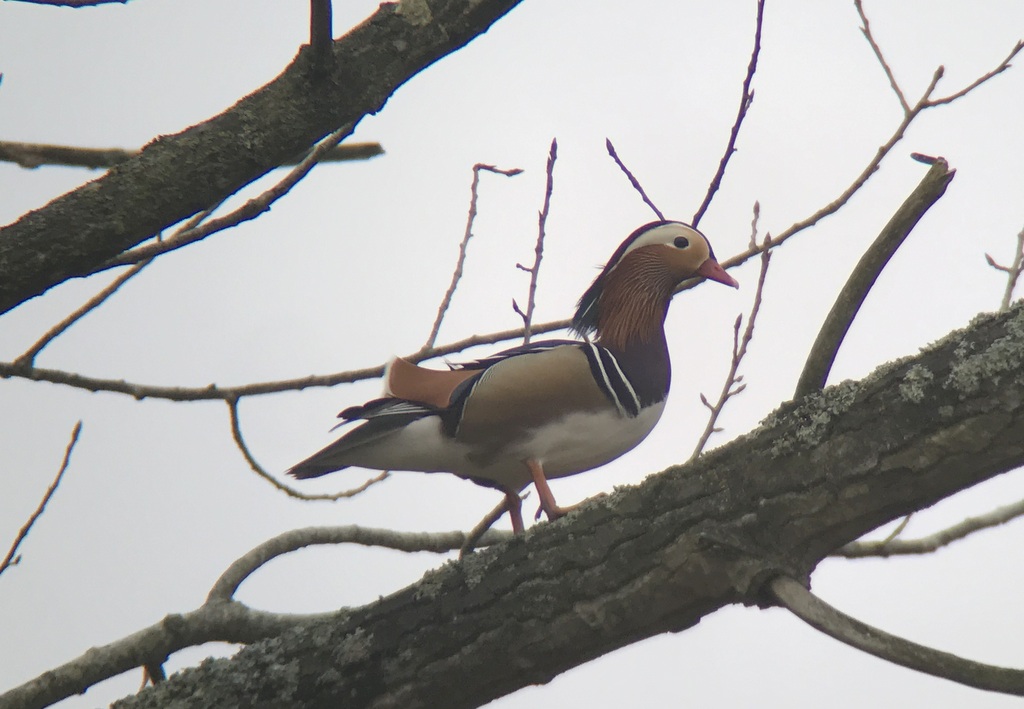
We had been told that the Lesser Spotted Woodpeckers had been around earlier this morning, but they had not been seen for around half an hour when we arrived. We stood and listened to see if we could hear them, and were rewarded with the wrong woodpeckers.
First, we could hear a Green Woodpecker laughing at us from the trees on the other side of the river. It gradually worked its way towards us and finally appeared on the dead trunk of a tree. Then we heard a Great Spotted Woodpecker drumming and shortly after another calling across the river. One eventually appeared in the top of one of the alder trees where we could get it in the scope.
That was a nice start, but not the one we were looking for. There were some other birds around – a Nuthatch appeared in the trees too, there were plenty of tits including Marsh Tit singing, Siskins zipped back and forth overhead and a big flock of Redwings flew up into the tops of the trees before heading off over our heads and across the river.
When we noticed a couple of people look up at a small bird heading towards us from the Suffolk side of the river, we looked up too to see a Lesser Spotted Woodpecker coming out way. It flew in over our heads and we thought it would land in the poplars in front of us, but instead it carried on over the trees and dropped down somewhere over the back, way off in the distance. At least we had seen a Lesser Spotted Woodpecker, but it was not the views we were hoping for this morning.
Thankfully we didn’t have to wait too long. After about ten minutes, we heard a Lesser Spotted Woodpecker call and one of the group spotted it right in the top of one of the poplars. We got the scope on it and everyone had a good look, before it flew towards us and landed in another tree a little closer. It perched there for a couple of minutes, in full view, before flying again and this time heading back over the river and away, off in the direction from where it had flown in earlier.
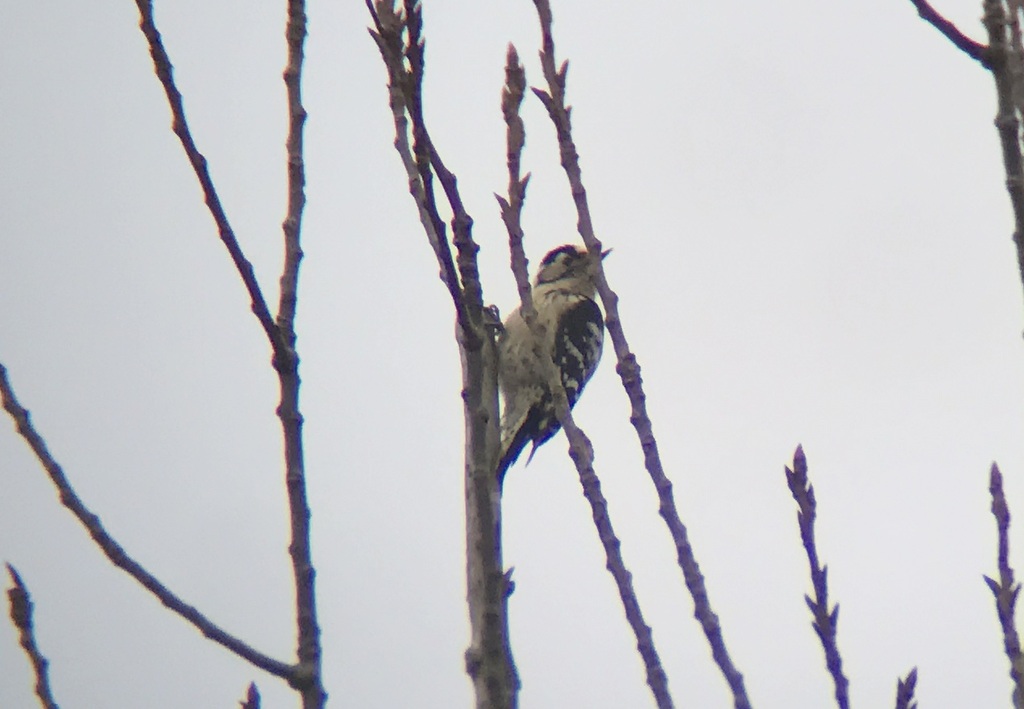
Lesser Spotted Woodpeckers are declining rapidly in the UK and we still don’t know why. So it was great to see one and to enjoy such good views of it. Even better, we got the full set of woodpeckers for the morning! With our main target achieved, we headed back along the path.
There were some Siskins in the alders on the other side of the river and when we stopped to look at them, one of the group asked whether we might see any redpolls too. Right on cue, we heard a redpoll calling and looked up to see one fly across and land in the top of one of the poplars by the path. Through the scope we could confirm that it was a Lesser Redpoll and a second bird, a smart red-breasted male, flew in to join it.
We had heard a Grey Wagtail calling back at the bridge earlier, while we had been distracted by the Kingfisher, but we hadn’t seen it. A quick scan from the bridge again when we got back and we spotted it picking around the base of one of the tangles of branches down along the bank just upstream. We walked up along the path beside the river and got it in the scope, a smart male Grey Wagtail with black throat.
There was still no news on the Parrot Crossbills, which had been coming in to drink in one of the ditches close by on the previous two days. It seemed like they must have decided to drink elsewhere again today. We had a quick look back at the area where they had been seen, which produced nice views of a singing Marsh Tit and a Common Buzzard which circled low overhead.

The churchyard at Santon Downham can be a good place to see Firecrest, so we had a wander up to look there. We heard several Goldcrests singing but not their scarcer cousin. It feels like the Firecrests have been slightly slow to get going this year, possibly in response to the colder weather in recent weeks. A Treecreeper appeared in the trees by the road too.
As forecast, the cloud was now starting to break and patches of blue sky were appearing. It felt quite a bit warmer too. A Sparrowhawk circled up over the village, flapping vigorously between glides, reminding us that it was getting to raptor o’clock and we should be heading off to look for one of our other targets soon.
We walked back down towards the car, stopping to look at the feeders by the bridge where a smart male Siskin was singing above our heads. The Kingfisher was showing well again, perched in the trees just by the bridge.

As we made our way over to look for Goshawks, the sun was out and the air was warming up nicely. Even though it was already after midday, to the Goshawks it was still late morning – perfect timing! When we arrived, there were already several Common Buzzards circling up above the trees. We hadn’t even had time to get the sandwiches out before we picked up our first Goshawks.
The initial ones we saw were rather distant. An adult male Goshawk was soaring high in the sky away to our right. Then a young male circled up above the trees too and started to display, flying across with slow, deep, deliberate wingbeats first before launching into a series of rollercoaster swoops, diving down, then turning sharply up, climbing vertically before stalling at the top and repeating over again. It gradually lost height, dropping down behind the trees.
Then another adult Goshawk appeared, a little bit closer. As it circled up it attracted the attention of one of the local Carrion Crows which decided to chase after it. The Crow mobbed it for several minutes, the Goshawk just jinking out of the way occasionally. After gaining height, it drifted off over the road and away to the west, until we lost sight of it, with the Crow still pursuing it.
We were busy watching the original young male Goshawk, which had come up again, when one of the group noticed yet another Goshawk circling up in front of us. This one, a different adult, was much closer, and we had a great view of it as it circled up, pale grey above and almost white below. It gained height very quickly, before drifting off north.
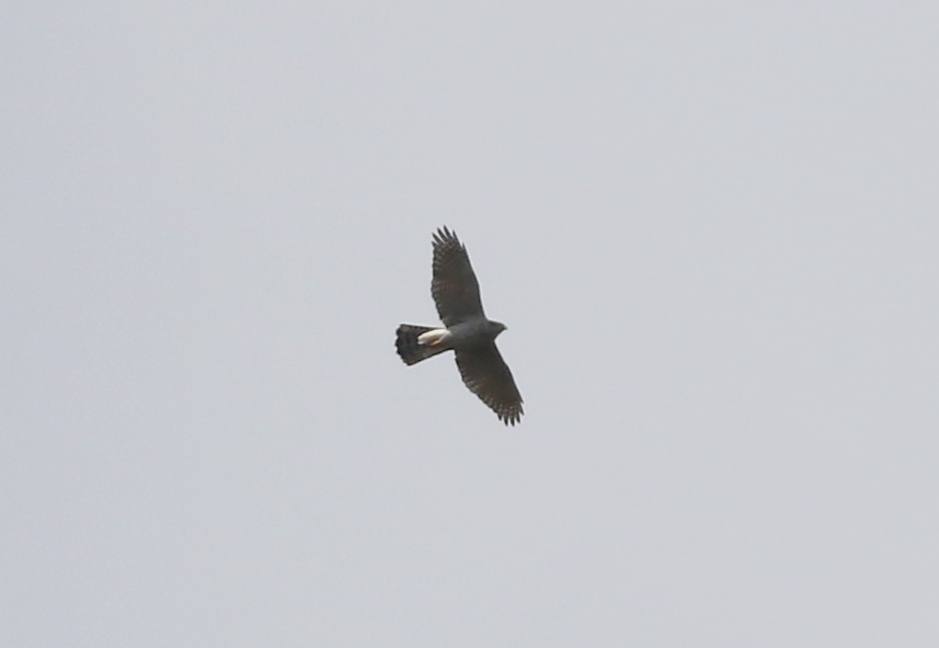
After that one disappeared, we turned our attention back to the young male Goshawk which was still displaying away to our right. The adult male was up again too now, and had clearly decided to chase off the interloper. It started to display, slow flapping, and headed straight towards the youngster, which decided to head off, and we lost it behind the trees.
In between all the Goshawk action, we had even found time to eat our lunch! There were other raptors up too – in addition to all the Common Buzzards, a Red Kite circled up and two Kestrels hovered over the field behind us. We had been really spoilt with raptors now, so we decided to head off and try something else.
We made our way round to a clearing to look for Woodlarks next. We thought they might be singing now, with the sun having come out, despite it being the middle of the day, but it was surprisingly quiet. We had a quick walk round, but it was rather disappointing – the only birds of note we saw were a Linnet singing in the tops of the trees close to where we parked and a smart male Yellowhammer perched in a low bush calling. A couple of Common Buzzards circled over, including a very pale bird, almost pure white below.
We decided to try something else and made our way over to Lynford Arboretum. As we walked in along the path, we had a great view of a couple of Goldcrests busy feeding low down in the larches. There was very little food left in the feeders from the gate and almost no birds down in the leaf litter, so we headed straight down towards the paddocks.
There were lots of birds coming down to the food put out on the pillars of the bridge. We stopped just long enough to admire a variety of tits, including several Marsh Tits which were coming in and out repeatedly, giving great close views.
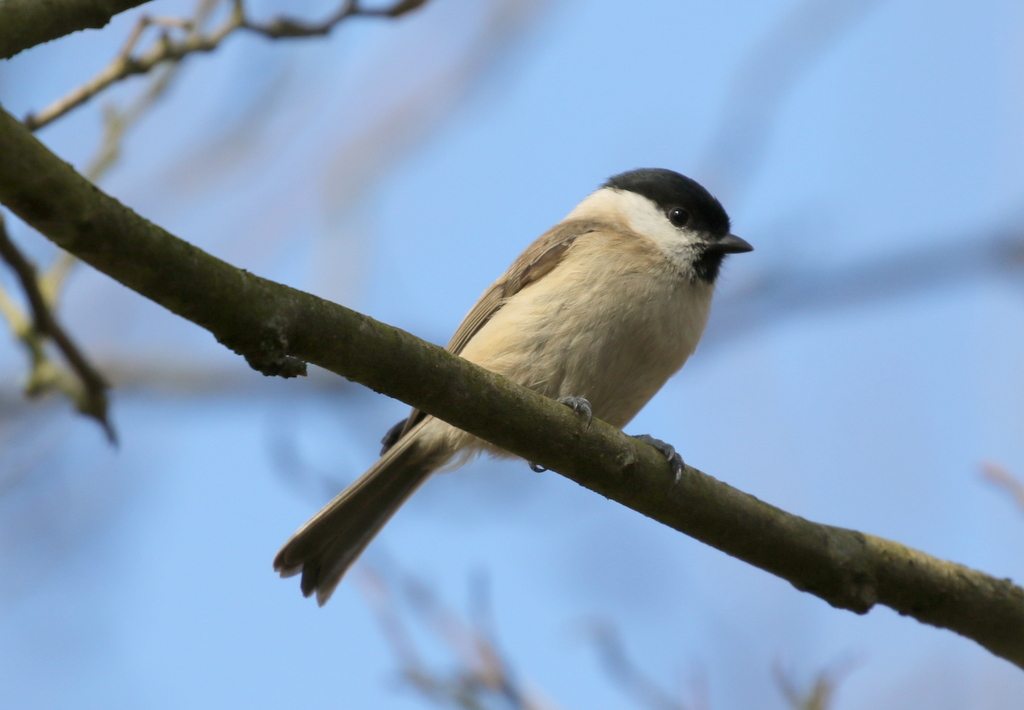
Hawfinch was our main target here, so we didn’t wait too long before continuing on down to the paddocks. We were quickly rewarded, as almost instantly something spooked all the finches and Redwings feeding under the trees out in the middle and we saw two larger birds with obviously white-tipped tails fly up. They were a pair Hawfinches and we got them in the scope as they dropped down to the ground again.

Over the next few minutes, the Hawfinches were continually dropping down to the ground and flying back up into the trees above, generally spooked by a cock Pheasant which insisted on calling loudly from time to time and shaking its wings, upsetting all the other birds. We had particularly good views of a female Hawfinch, which perched on a dead branch lying on the ground for a minute or so at one point, and then showed very well in a low hawthorn, climbing about in the branches and feeding on the leaf buds.
When two Hawfinches flew up from the trees and off towards the Arboretum, we though at first that was the pair we had been watching, but looking back at the hawthorn the female was still there in the branches. Then we noticed a male Hawfinch had appeared and was perched slightly higher up. Through the scope, we could see his much richer chestnut colouration, really striking in the afternoon sun.
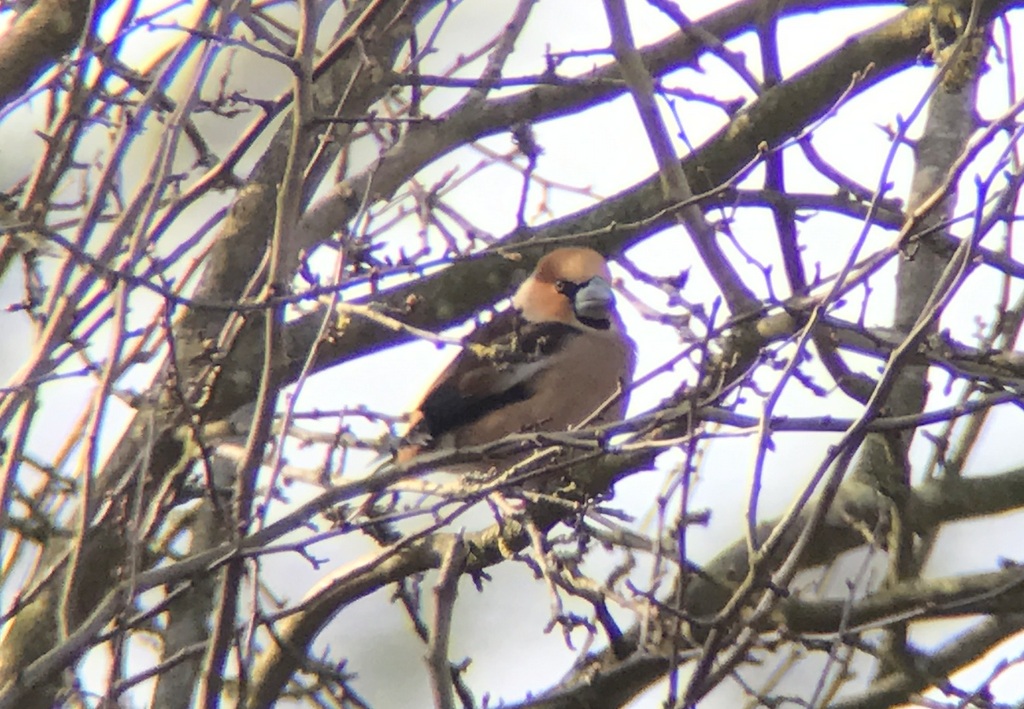
When the Hawfinches finally disappeared back into the trees, we decided to walk back to the bridge. We topped up the seed mix on the pillars with a generous handful of sunflower seeds, and the Nuthatches appeared to appreciate it, coming in and out regularly to grab a beakful.

As well as all the tits coming and going, there were Chaffinches and Dunnocks too. The Siskins were not here for the seeds, but were feeding in the alders nearby and we had great views of a bright male just above our heads.

It was time to start making our way back, so we walked up to the car park. We stopped for a minute and listened, but there was no sign of any Firecrests singing here either today, although it was hard to hear anything at times with all the cars and people coming and going. Then we noticed some movement high in one of the fir trees and as we looked up with binoculars, a Firecrest flitted out and landed on a branch.
Unfortunately, by the time the rest if the group had made it over, the Firecrest had disappeared and been replaced by a Goldcrest instead. It was a frustrating few minutes before the Firecrest finally appeared on the edge of the next fir tree along and we all had a good view of it flitting in and out of the branches high above our heads.
We still had time for one last stop on our way back. The first Stone Curlews which had returned a week or so back had become rather elusive since the snow, so we weren’t sure we would be able to find them today. We stopped to scan the field where they often like to roost during the day, but there was no sign of them. A Tree Sparrow in the hedge nearby was some compensation.
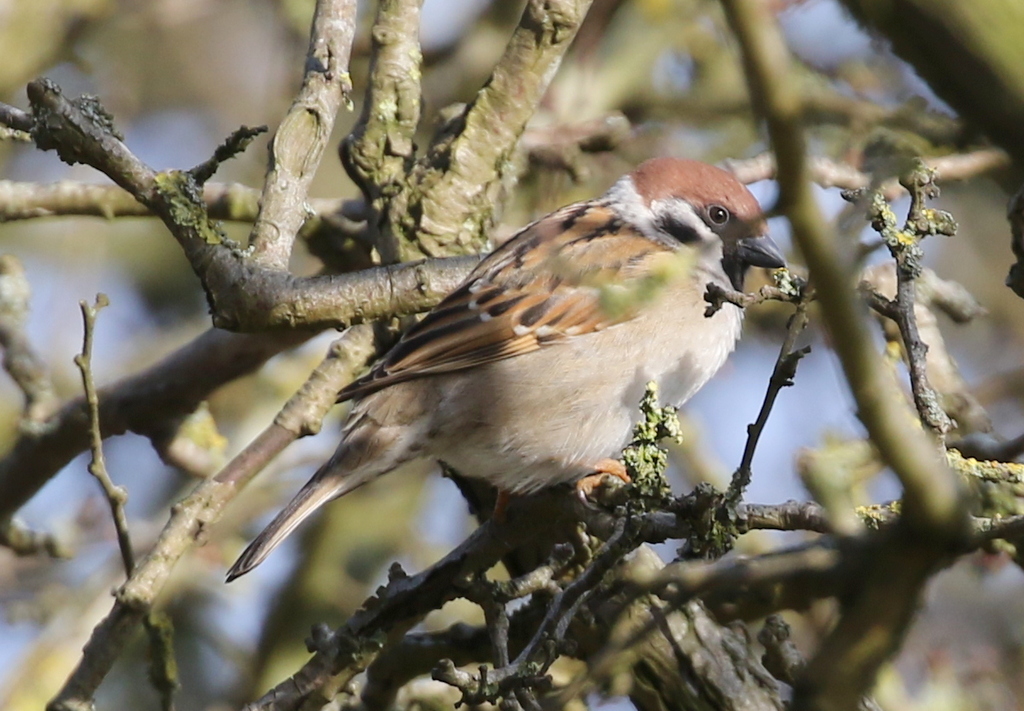
The Stone Curlews are not in the pig fields so often at this time of year, but we decided to have a look anyway just in case and there they were, three Stone Curlews. We got them in the scope and had a good look at them, noting their staring yellow eyes and short yellow and black bills. They didn’t appear at all concerned by the pigs walking either side of them!
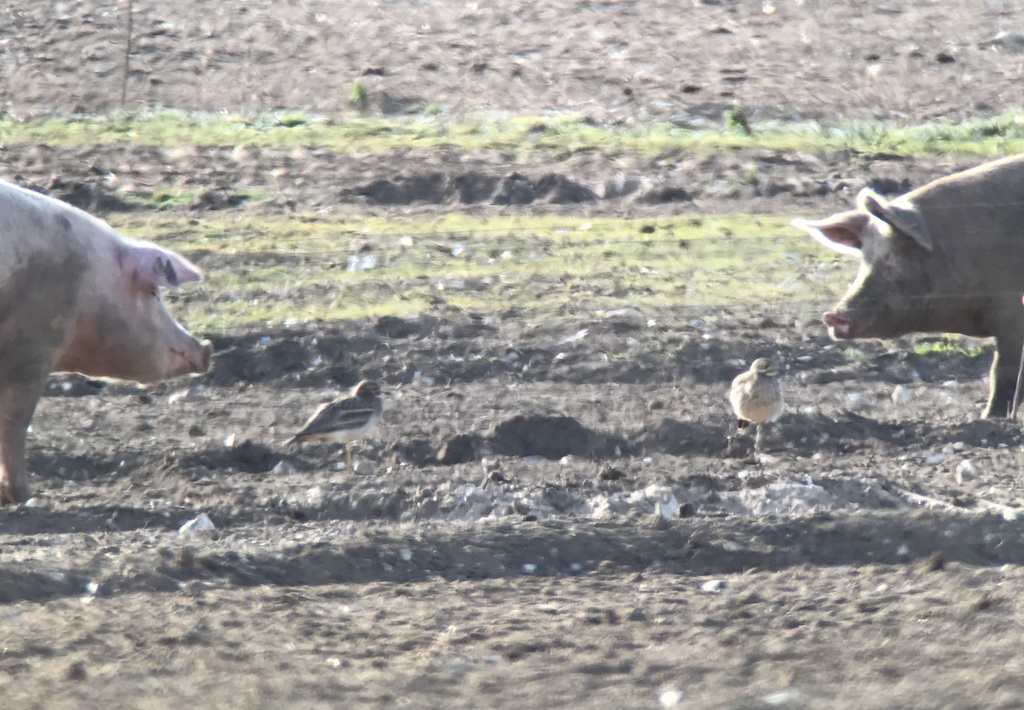
That was a great way to end the tour, watching the Stone Curlews out in the field. It had been a really enjoyable couple of days with some good birds and excellent company. Time to head for home!
















